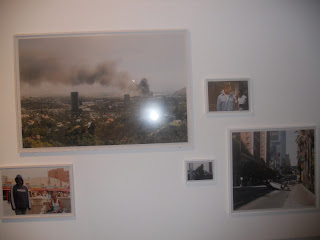MACRO Future
September 24- October 24
www.en.macro.roma.museum
By Monet McCord
The exhibition at MACRO (Museo D’Arte Comtemporane Roma) Testaccio Museum currently being shown is the FotoGrafia Festival Internazionale di Roma (IX Edizione). The show is presenting FuturSpectives while posing the question: Can photography predict the future? The show consists of three sections, Bumpy Ride, Maps and Legends, and Unpublished-Unknown with various artworks by multiple artists. The show is also complemented by three additional sections; Opera Citta’ with works by Tad Papageorge, Ecclesia by Giuliano Matteucci, and a preview of Mutations 3 by the European Month of Photography.
The location of the museum and the facilities used were once a slaughterhouse. The facility still maintains some of the rails and meat hooks that were apart of its original function. Keeping original parts of the slaughterhouse shows the history of the location while the artworks that are presented at this museum are always contemporary. It is a good balance of past and present, and with this exhibition a sneak peak of the future.
There are two buildings that house artworks. As you enter the two-story museum there are alcoves along the length of the museum with photographs by various artists. Two artists that had the most contrasting photos compared to the other artists were Mirko Martin and O Zhang. Mirko Martin photographs titled LA Crash were apart of the section Bumpy Ride. His photos depicted the various scenes of the poverty stricken neighborhoods contrasted with photos of the tall, capitalistic, money driven sky-scrappers that are home to Downtown Los Angeles. It is a struggle between the utopian idea of Los Angeles and the reality of gangs, violence, racism, and poverty that exist amongst the great buildings of success. As you exit the alcove or Mirko Martin you are faced with a wall full of Kodak like photos of young girls taken by O Zhang, titled Horizon. Although the photos are bright of full of exuberant colors, the facial expressions on the young girls faces prove that they are not as happy as the colors portray them to be. Only after reading the caption are you aware that the photos are of young girls that families do not want due to traditional Chinese cultural norms of having one child only or simply because they are female and not deemed important. Photos like these definitely answer the question of whether or not photos can predict the future. These young girls are the future and if they are harmed and not wanted then how will the future ever come to exist? The positioning and size of these photos at the end of the museum reinforces the theme of the exhibition.
The single story museum included more interactive photographic art works, from Internet based works self-operating slide shows. The use of technology is hinting at what society has become consumed in, the use of social networks, interactive web browsers, and slide shows. Artists like Jon Rafman whose work presented here, Cambie Road, is a photograph thanks to Google Street View Internet service. Such innovation makes it possible for people to see neighborhoods of other cities, states, and countries without every physically being there. It is making the world a more personal place without the contact of people. It is this irony that fuels the expectations and greatness to come in the future. It is such advances along with social networks like MySpace and Twitter as presented by Filippo Minelli’s Facebookphotos, in which people are always connected without ever being physically in contact. His works of art depict scenes from various parts of a city with the words of these social networks spray painted boldly obstructing the original content in the image. It is as if it does belong there, it is an addition that is not wanted.
The use of photography to capture the past and present to predict the future was evident in the works presented in this exhibition. From the photos of young Chinese girls to the interactive Google Street View applications, it is clear that the future is becoming more and more less interested in human lives and human contact and more concerned with communication via technology. The artworks hint at what is already happening in society. Most people communicate with each other via text message or many social networks online before making a voice phone call or appearance in person. This may lead to a more impersonal relationship but people are able to communicate way more without being in contact with one another, it removes that insecurity we all have of being awkward. Soon there may be no need to attend a gallery or museum because one may be able to get a live show online and all the works will be interactive with some form of technology. New mediums of art are constantly being added to the art scene and only time will be able to tell us what is to come next.



Nessun commento:
Posta un commento
Nota. Solo i membri di questo blog possono postare un commento.